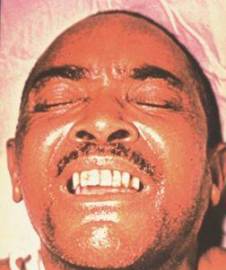Tetanus
Introduction.
Tetanus, also called lockjaw, results from an infection with Clostridium
tetani. These bacteria are strict anaerobes and are able to survive in deep
puncture wounds. Once in the body, they multiply and secrete an AB-type exotoxin
(Tetanus toxin) which blocks release of inhibitory neurotransmitters in the CNS.
This causes spastic paralysis.
Summary
Cause:
Clostridium tetani: Gram-positive strictly anaerobic endosporing rods
in the Phylum Firmicutes
Symptoms:
Spastic paralysis of facial muscles, progressing to other
skeletal muscles and the diaphragm. Can lead to death through paralysis of
respiratory muscles.
Transmission:
Most commonly through wound infection, often deep puncture wounds
(e.g. "rusty nail")
Pathogenesis:
C. tetani grow in the anaerobic tissues and produce Tetanus toxin (an
Exotoxin) that travels
to the CNS in the bloodstream. There, it blocks the release of an inhibitory neuotransmitter
(GABA) which normally inhibits motor neurons.
Treatment:
Adminitration of an antitoxin is necessary to neutralize circulating toxins;
The DPT vaccine (diphtheria/pertussis/tetanus) prevents illness;
periodic boosters are necessary. Antibiotics are generally not needed or
effective
|
![]()